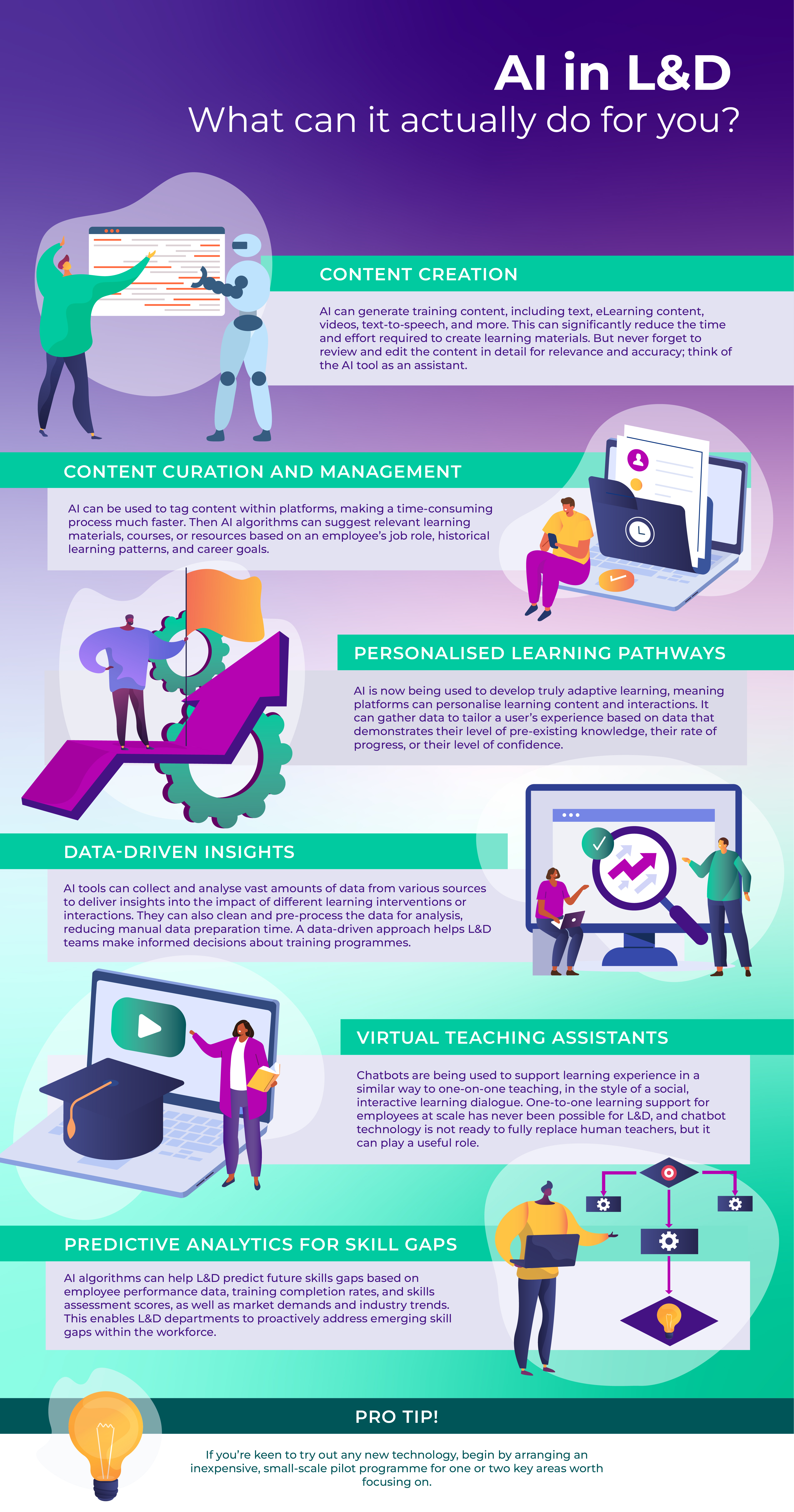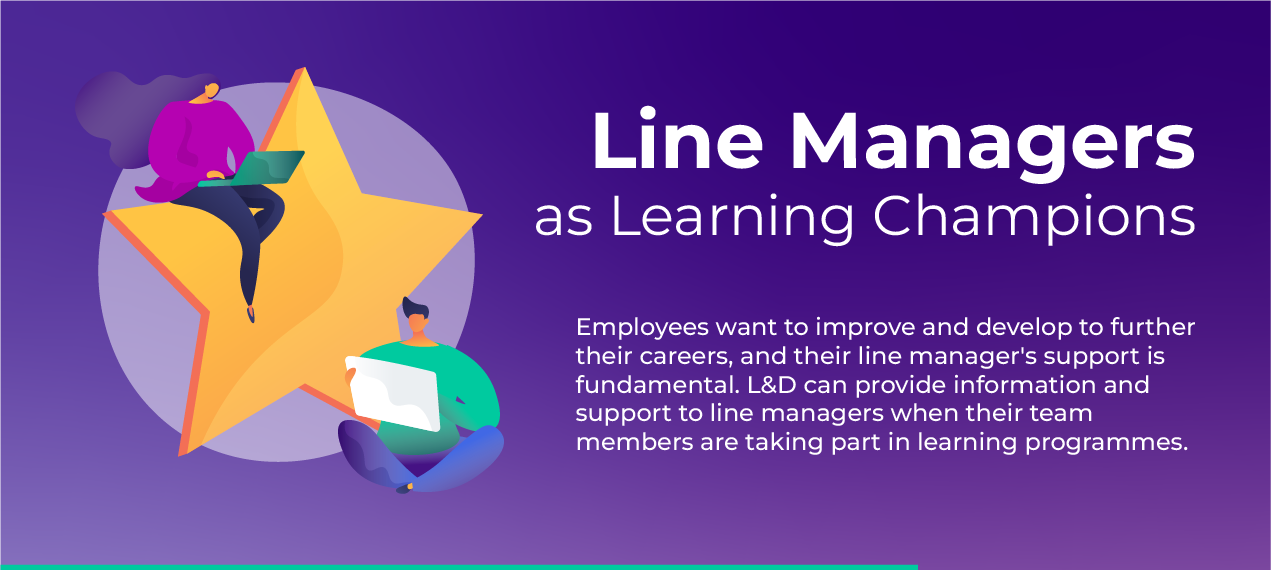The recent explosion in AI, and the current trend of “quiet hiring” are just two areas that can disrupt an organisation’s approach to people management and development, so join us as we dive deeper and present some suggestions for action.
AI
AI – and generative AI in particular – is very much in the news these days. Even since the start of 2023, there have been major announcements on ChatGPT (and its integration into Microsoft’s Bing search engine), Google’s Bard, and other text-based AIs. We’ve also seen aggregate sites such as Futurepedia spring up to help us keep track of new AI-based business ventures (on the day this article was written, Futurepedia reported 29 new AI tools added today, offering services related to images, voice, music, food, productivity, and more).
AI is not perfect by any means, but it can clearly handle some tasks that are currently carried out by human beings (and it’s only going to get better). For example, my colleague Andrew has written about AI’s implications for learning writers. AI’s impact isn’t clearcut – in every case (as we saw with Andrew’s example), AI can complete certain tasks, and there are other aspects where a human will out-perform it.
What's also interesting is the way people are combining AIs in new and innovative ways, sparked by human curiosity. For example, content creators are using output from ChatGPT to feed into Midjourney (an image generating AI) and using the output from that in other AI tools to generate videos and other content. This mixing and matching of different AIs opens up even more opportunities for growth and development (and also, for confusion, as the number of combinations grows). There are new skills needed here, in assembling different AI components and in prompt engineering to give us the solutions we need.
Clearly, there are limits with AI. BCG recently noted [see references below] that “generative AI lacks a credible truth function, meaning that it doesn’t know when information is factually incorrect.” And there are other challenges, too, in terms of cybersecurity, inbuilt biases and prejudices, and legal regulation. But there is still tremendous scope for AI to affect the work of the organisation, such that a lot of the standard, routine work that relies on well-understood or codified knowledge might not need as much human intervention (see, for example, Jarche – reference below). This has been a trend for many years – since the introduction of IT, some would say – but there’s such explosive growth now that this might happen much more quickly than we might have thought even a year ago, with some existing roles changing and others simply disappearing.
Quiet hiring
Another trend that we have looked at is talent management. Even taking into account the layoffs in the tech sector in the first quarter of 2023, we are still in a period of low unemployment. Organisations are continuing to look at employee retention, trying to find the right balance with hybrid working, and providing coaching and mentoring as part of their talent development programmes. Right now, the specific trend in this area seems to be quiet hiring – where organisations try to expand their capabilities without bringing in new full-time employees. They generally do this in at least one of the following ways:
- Internal hiring, based on skills needed in particular areas or for specific tasks or projects
- Providing opportunities for employees to develop their skills in line with the organisation’s needs
- Bringing in freelancers for specific purposes, where there are currently skills gaps.
(Josh Bersin fairly makes the point that this is not a new thing: companies are working on internal mobility, career pathways, job redesign, and so on already – and have been, for some time.)
Quiet hiring needs good management, and close involvement of employees to avoid a perception that they’re being exploited: co-creation of the systems and processes around this can ensure buy-in. You also cannot expect that with this approach, employees will immediately take control of their own career direction and professional development. The organisation needs to take responsibility for managing this, making time available, encouraging employees, and ensuring that managers are open and proactive.
Skills
Both of these trends point to a skills-based approach to people management and development.
To get the most out of AI, we need to rethink our notion of what a “job” or a role is: break it down into a set of skills or abilities, then decide which of those are “human” and which are “machine”. Deloitte refers to this as “the end of jobs”, which may sound alarming, but if managed properly, it can lead to greater business agility and worker autonomy and growth.
For quiet hiring, again a focus on skills provides a way forward. This is more about understanding the overall skills landscape of your organisation, thinking about the skills the organisation will need going forward (including AI-related skills), identifying skills gaps, and planning how you can encourage employees to reskill, upskill, or cross-skill.
Implications
According to Deloitte, the workplace of the future is one where skills replace jobs as the focal point. Rather than being stuck in a particular role, every employee has a set of skills, and can work beyond formal job boundaries.
Think of your workplace as an all-inclusive boundaryless ecosystem…workers have different needs and make valuable contributions in different ways
This gives organisations the flexibility and adaptability they need to respond to the external environment, to develop new skills, and it also gives employees more input and control over their careers, and the skills they want to build.
There’s a lot of work involved in getting there, and for many of us, moving to a boundaryless ecosystem may seem a little daunting. That’s fine: you can always start with a focus on skills, and internal mobility. These will bring more immediate benefit to your organisation and employees, and also position you for a boundaryless ecosystem in the future if that becomes a priority for you.
Here are our tips to get you started:
- Set out from the start to co-create your skills landscape with your employees, to increase engagement and guard against cynicism or disillusionment around the new focus and the changes that it brings for them.
- Begin establishing pathways for internal mobility.
- Inspire your employees to look more broadly at their career choices and future options
- Create an expectation at all levels that while employees need to be proactive in their career planning, managers need to create opportunities, support employees, and hold those employees to account.
- Run programmes to match people with project opportunities across the organisation, in other business areas to experience different projects and build skills, in line with their career development goals, and the organisation’s needs.
- Establish a skills framework to underpin the above points: to identify skills gaps in the organisation, to provide structure for career choices, management support, and internal mobility
- As we’re talking about skills, focus on experiential and social learning, rather than formal learning opportunities. By working as part of a project team in a new area, employees can learn by doing, and learn from others, minimising the need for any formal courses.
There’s a major health warning with this approach: often, organisations want their employees to own their professional development. This generally doesn’t work, unless you back it up with organisational support, and management involvement. Without this, any initiative around “owning your own development” is likely to fall flat or feel shallow and dishonest. There needs to be just as much focus on the responsibility of the organisation as there is on the individual responsibility of the employee. The manager’s role here is more than just to support the employee: it’s to coach them, and hold them to account. ‘Learning’ needs to be treated with the same priority as the employee’s other work.
L&D’s role
Your first challenge might be to establish how much a skills-based approach is relevant in your organisation. It may be that in your industry or your organisation, a skills-based approach is not a priority. What’s more likely, we feel, is that there are some initiatives in this area that you can tap into and support.
There's always groundwork to start with, or to keep on top of. Have conversations with business leaders about perceived skills gaps, ask employees for their perceptions about their own skills. Consult on what skills are needed and where, what support is currently in place, and what more could be done, to map out a way forward. Here at Logicearth, we are launching a new online tool called “Inniu” to help guide and structure conversations around skills. It’s not AI – it’s all about facilitating human conversations – but it could be one way to kickstart your move to a skills-based boundaryless ecosystem, ready to meet the demands of a rapidly changing world.
With thanks to Beth, Eoin, Helen, and Richard for your contributions, feedback, and comments.
References, sources, and related reading
Heap, A. (n.d.). The effect of AI on learning writers. [online] blog.logicearth.com. Available at: https://blog.logicearth.com/the-effect-on-learning-writers
BCG Global. (2023). The CEO’s Guide to the Generative AI Revolution. [online] Available at: https://www.bcg.com/publications/2023/ceo-guide-to-ai-revolution.
jarche.com. (n.d.). our machines are tools and not our friends. [online] Available at: https://jarche.com/2023/04/our-machines-are-tools-and-not-our-friends/
Josh Bersin on LinkedIn: ‘Quiet hiring’ is the opposite of quiet quitting, and workers are furious… [online] Available at: https://www.linkedin.com/posts/bersin_quiet-hiring-is-the-opposite-of-quiet-quitting-activity-7019361818032685056-yza4/
Deloitte (2023). 2023 Global Human Capital Trends. [online] Deloitte Insights. Available at: https://www2.deloitte.com/us/en/insights/focus/human-capital-trends.html.
McRae, E.R. and Aykens, P. (2022). 9 Future of Work Trends For 2023. [online] Gartner. Available at: https://www.gartner.com/en/articles/9-future-of-work-trends-for-2023.
Loutfi, E. (2023). It’s time to discuss the problem with ‘owning your own development’. [online] Chief Learning Officer - CLO Media. Available at: https://www.chieflearningofficer.com/2023/02/28/its-time-to-discuss-the-problem-with-owning-your-own-development/
HR Magazine. (n.d.). HR Magazine - How to create a culture of lifelong learning. [online] Available at: https://www.hrmagazine.co.uk/content/insights/how-to-create-a-culture-of-lifelong-learning
McKinsey (2023). What is ChatGPT, DALL-E, and generative AI? | McKinsey. [online] www.mckinsey.com. Available at: https://www.mckinsey.com/featured-insights/mckinsey-explainers/what-is-generative-ai.
webinar.gartner.com. (n.d.). Which Future of Work Models Retain Staff and Power Their Performance. [online] Available at: https://webinar.gartner.com/461362/agenda/session/1088584?login=ML (may require login / registration)
Talk to us today if you would like to find out how we can help you with your L&D offering!







Is this article interesting?